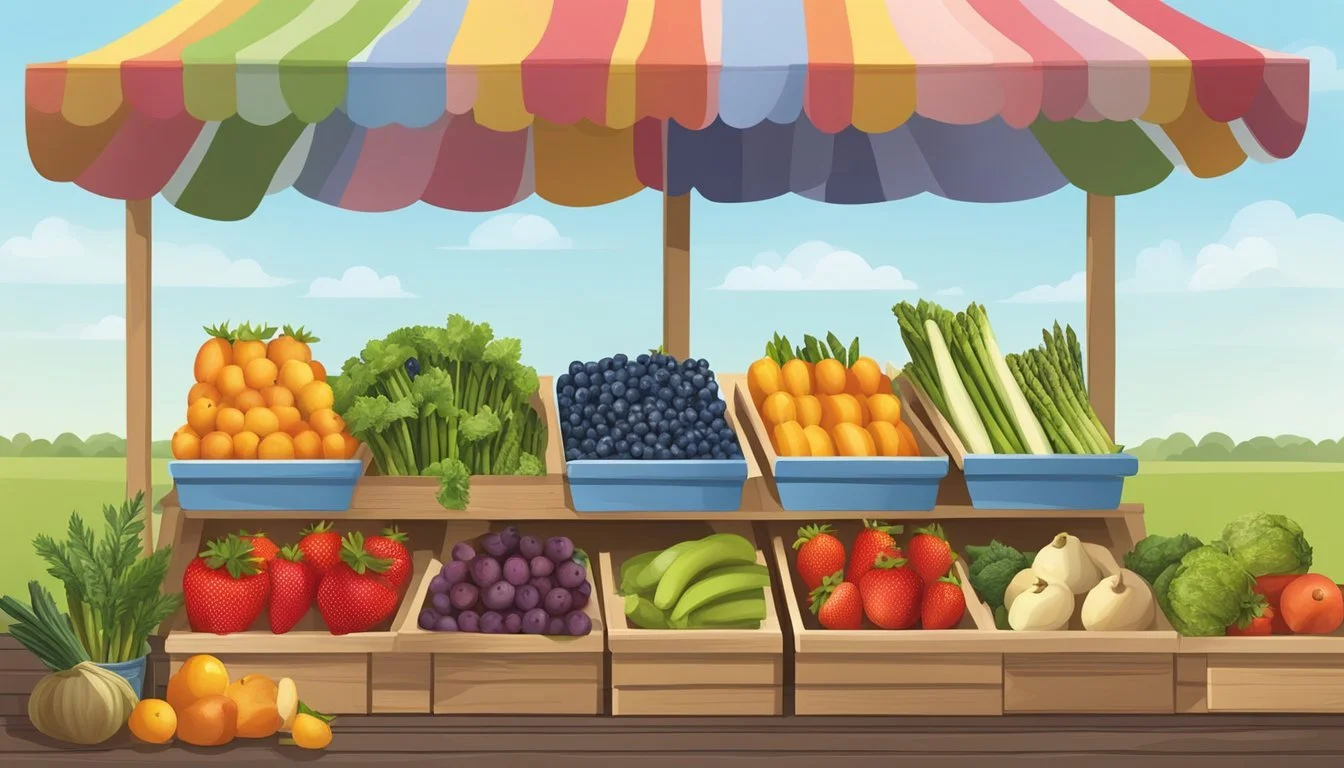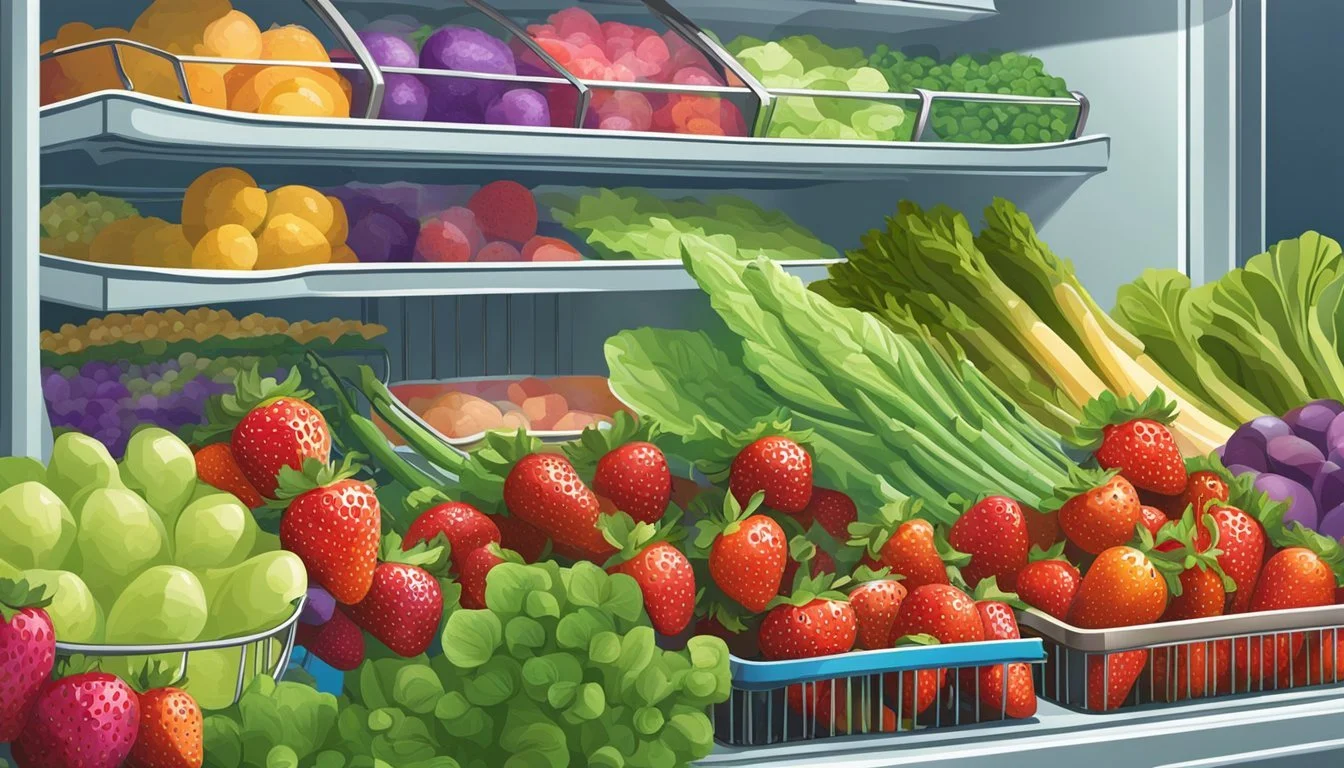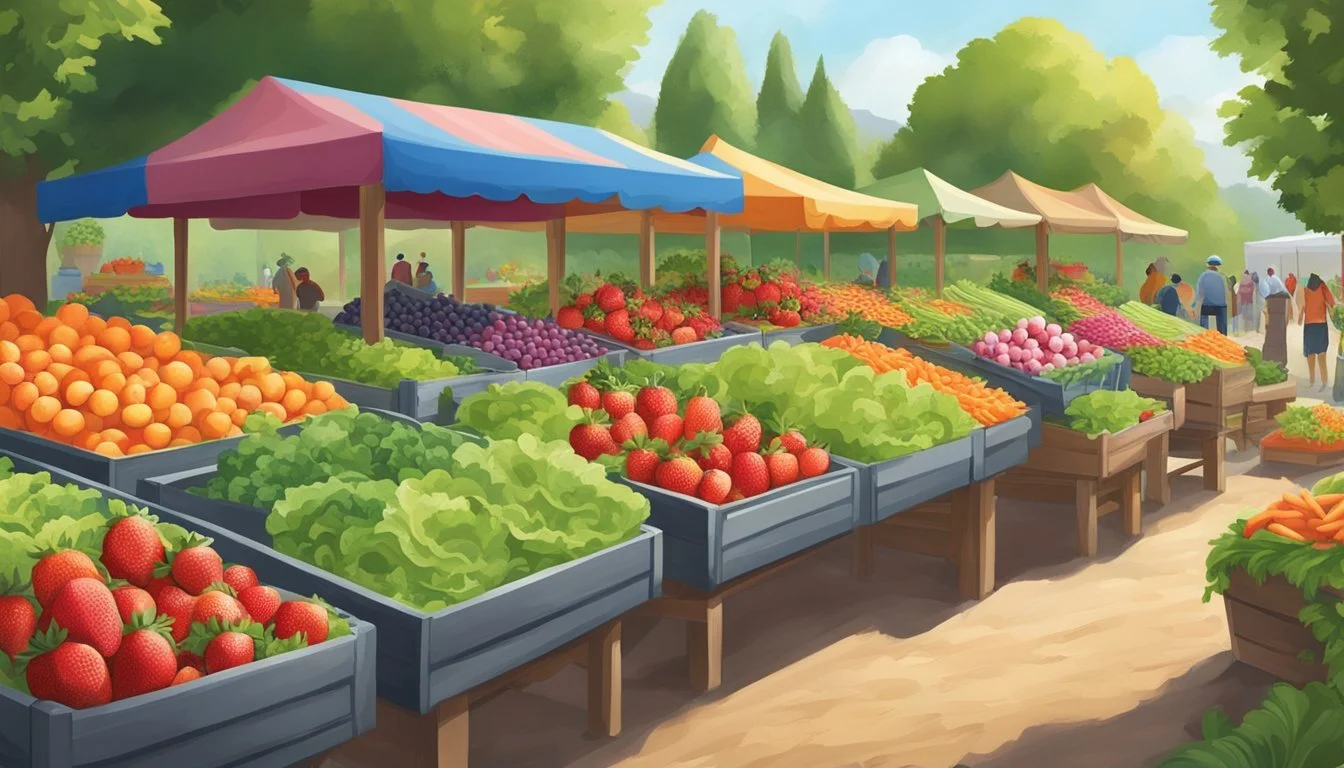Kentucky Seasonal Fruit & Vegetables in April
Your Fresh Guide
This Article is Part of our Kentucky Seasonal Fruit & Veg Calendar
April marks a transitional period in Kentucky's agricultural calendar, when the first signs of spring begin to influence local produce offerings. As winter's chill gives way to milder temperatures, Kentucky fields and farms start yielding a variety of fresh, seasonal fruits and vegetables. Consumers and chefs alike look forward to this month for the opportunity to incorporate these newly available ingredients into their culinary repertoire.
Among the early arrivals to the Kentucky produce scene in April are leafy greens, including spinach (What wine goes well with spinach?) and kale, respected for their versatility and nutrient density. This month also sees the emergence of several root vegetables, such as radishes and turnips, offering a crisp, peppery bite to spring dishes. These vegetables are just a few examples of the seasonal bounty that begins to flourish, marking a time of rejuvenation in the Bluegrass State's local food systems.
This guide into April's seasonal fruits and vegetables in Kentucky provides an essential reference for those aiming to enjoy the freshest possible produce. While fruit options are less abundant, stored varieties of apples from previous harvests remain available and are a testament to the state's ability to provide locally-grown options year-round. Being informed about the seasonal availability of produce not only supports local agriculture but also ensures peak flavor and nutrition on the table.
Seasonal Overview
In April, Kentucky's agricultural tapestry begins to show vibrant colors as a variety of fruits and vegetables reach their optimal harvest times, offering fresh and healthy options to the state's residents and markets.
Understanding Seasons
Spring marks a period of regrowth and rejuvenation in Kentucky's farming cycle. This season ushers in a wave of fresh produce, with the soil temperatures warming and daylight hours extending. The rhythm of the seasons dictates the availability of produce, and understanding this natural cycle is crucial for consumers seeking the freshest, most nutritious offerings. In-season produce not only boasts a higher nutritional value but also supports the local economy and reduces the carbon footprint associated with long-distance transportation.
April in Kentucky
As one enters April in the Bluegrass State, they are greeted by the burgeoning life of spring crops. The seasonal transition notably affects what's available in markets and on plates:
Fruits:
Strawberries begin to appear towards the end of the month.
Stored apples from previous harvests are still available.
Vegetables:
Leafy greens like spinach and kale are in abundance.
Root vegetables such as radishes and turnips can be readily found.
Cruciferous vegetables like cabbages and broccoli continue to thrive.
Farmers across the state are actively planting and preparing for the upcoming peak seasons, while consumers enjoy a range of healthful options offered by the April harvest.
Fruits in Season
April in Kentucky ushers in the first flush of the fruit season, marked by the arrival of early strawberries and a selection of spring fruits. This period is known for its bright flavors and the anticipation of more abundant harvests as the season progresses.
Strawberries
As spring sets in, strawberries begin to make their appearance in Kentucky. Consumers eagerly await the first harvest, which offers a fresh and tangy flavor that is synonymous with the season. Strawberry season in Kentucky can be brief, so people are encouraged to enjoy these berries while they're at their peak.
Spring Fruits
While strawberries are often the stars of early spring, other fruits start to become available:
Blueberries: They begin to ripen later in the season but are on the verge of being ready.
Blackberries: (how long do blackberries last?) Similar to blueberries, blackberries are not yet at their peak but preparations for the upcoming harvest are underway.
These fruits hold the promise of the full-flavored bounty that the warmer months will bring.
Vegetables in Season
As April's gentle warmth coaxes life from the Kentucky soil, the state's gardens bloom with a variety of seasonal vegetables. This month is known for offering a fresh abundance of leafy greens, crunchy root vegetables, and crisp podded vegetables, each heralding the arrival of spring with their own unique flavors and textures.
Leafy Greens
In April, leafy greens are thriving, presenting a perfect opportunity for salads and healthy sautéed dishes. (What Wine Pairs Best with Sautéed Dishes) One can find a variety of fresh lettuce, including butterhead and romaine, along with other greens such as spinach. The greens are not just abundant but also packed with nutrients and bursting with freshness.
Lettuce: Includes varieties like butterhead and romaine
Spinach: Tender and versatile for many dishes
Kale: Curly and flat-leaf varieties are on offer
Root Vegetables
Root vegetables are also a wise choice during this month, offering both flavor and grounding substance to meals. Earthy radishes offer a peppery kick, ideal for refreshing salads or garnishes.
Radishes: Adds a peppery flavor to dishes
Podded Vegetables
Podded vegetables are beginning to make their mark in the seasonal repertoire. Peas, especially, are in their prime, introducing sweetness and a delightful crunch to any meal they grace.
Peas: Sweet green peas can be enjoyed fresh or cooked
Herbs and More
Kentucky's April gardens offer an array of herbs that are essential for culinary use, providing both flavor enhancement and nutritional benefits. These aromatic plants are at their peak, ready to be picked and added to a variety of recipes.
Popular Herbs
Chives: (how long do chives last?) They are tender and perfect for snipping into salads and as garnish for spring dishes. Chives add a mild onion-like flavor that complements eggs, potatoes, and soups.
Cilantro: Known for its bold, citrusy profile, cilantro is frequently used in salsas and Mexican cuisine. It's a cool-weather herb that thrives in Kentucky's April climate.
Parsley: This versatile herb, either as flat-leaf or curly, is abundant and lends a fresh, slightly peppery taste to dishes.
Other Seasonal Picks
Mint: A hardy perennial that springs to life during this month, mint is indispensable in drinks, desserts, and Middle Eastern recipes.
Oregano: Their small, pointed leaves carry a potent flavor, indispensable in Italian and Mediterranean cooking.
Thyme: With its tiny leaves, thyme is a robust herb perfect for slow-cooked meals (how long do cooked meals last?); it withstands prolonged cooking, imparting a subtle earthiness.
Shopping and Storing Tips
When shopping for seasonal produce in Kentucky, consumers should focus on selecting the freshest items and follow appropriate storage practices to ensure longevity and flavor.
Selecting Fresh Produce
When selecting leafy greens and other produce at the market or store, one should look for vibrant coloring and crisp textures, which are indicators of freshness and quality. Careful examination for blemishes or signs of wilting can help in choosing the best quality produce. Farmers may also provide insight into what's most fresh.
Leafy Greens: Look for bright, firm leaves; avoid yellowing or limp bundles.
Berries: Select plump, brightly colored berries without mold.
Asparagus (What wine goes well with asparagus?): Choose stalks that are straight and firm with tight, closed tips.
Storage Practices
Once purchased, proper storage is crucial to retain freshness and extend shelf life. Different types of produce require varying conditions; some need refrigeration, while others are best kept at room temperature.
Refrigerate in Crisper Drawer or Container:
Leafy greens: Wrap in paper towels, place in a container/bag.
Berries: Use within 1-2 days if kept on the countertop, otherwise refrigerate.
Asparagus: Trim ends, place upright in a container with water, cover, and refrigerate.
Room Temperature:
Tomatoes: Store on the countertop away from direct sunlight.
Potatoes: Keep in a cool, dark, well-ventilated area.
One should remember to adjust storage practices based on how quickly they intend to use the produce. Freshness degrades over time, so plan accordingly for best taste and nutritional value.
Preparing and Cooking
In April, Kentucky's bounty of seasonal produce offers fresh flavors that shine with minimal cooking. Techniques like steaming for asparagus and grilling for spring onions highlight the vegetables' natural tastes, while salads and soups provide a canvas for a variety of ingredients.
Recipe Ideas
Salads: Toss tender spring greens with sliced strawberries and goat cheese for a refreshing salad. Drizzle with balsamic vinaigrette.
Soup: Create a vibrant spring vegetable soup using carrots, young potatoes, and leeks. Garnish with fresh herbs.
Pizza: Top your pizza dough with sautéed spinach, morel mushrooms, and fresh mozzarella for a seasonal twist.
Cooking Techniques
Grill: Grill spring onions and asparagus for a smoky flavor, then finish with a squeeze of lemon and a sprinkle of sea salt (how long does sea salt last?).
Roast: Roast radishes and new potatoes tossed in olive oil and herbs until they’re caramelized and tender.
Steam: Steam fava beans (how long do fava beans last?) and peas briefly to maintain their bright green color and sweet flavor, then enrich with a pat of butter.
Benefits of Eating Seasonally
Eating seasonally brings numerous advantages to one's health and to the environment. When consumers choose seasonal produce, they are often rewarded with fruits and vegetables that are at their peak in both flavor and nutrients. For example, Kentucky seasonal crops in April may include kale and spinach, which are particularly high in fiber and essential vitamins.
Fruits and vegetables consumed during their appropriate seasons tend to have a richer flavor. This is because they are harvested at the correct time for optimum taste and quality. Seasonal farming practices typically align with natural cycles, yielding produce that is more likely to be fresher and fully ripened.
The health benefits are backed by a higher concentration of nutrients. Seasonal fruits and vegetables have had the appropriate time to grow and mature, resulting in higher nutritional content. This means an intake of more vitamins and minerals, such as vitamin C and antioxidants, which are crucial for maintaining a robust immune system.
Consumers also support local farming communities by eating seasonally. It encourages a sustainable food economy and reduces the carbon footprint caused by long-distance transportation of non-seasonal produce.
When considering fiber intake, which is vital for digestive health, seasonal produce like berries and apples provide an excellent source. These crops, when eaten in their season, maintain their natural dietary fiber, which can aid in digestion and weight management.
In summary, the choice to consume seasonally ensures fresher, tastier, and more nutritious produce, promotes environmental sustainability, and bolsters local farming economies.
Kentucky's Farming and Markets
Kentucky's farms flourish in a wide range of agricultural ventures, from nurturing extensive fields of grain to maintaining vibrant orchards and vegetable plots. As April heralds spring, local produce begins to emerge at various markets, showcasing the dedication and labor of Kentucky farmers.
Local Produce: Kentucky markets teem with fresh, seasonal produce during April. Consumers are likely to find an array of greens such as spinach and kale, alongside early harvests of radishes and turnips.
Farming Practices: With a focus on sustainable practices, Kentucky's farmers often utilize crop rotation and integrated pest management to yield high-quality produce.
Farmers and Markets: They engage with the community through farmer's markets and farm-to-table initiatives, creating avenues for fresh, locally-grown fruits and vegetables to reach the consumers' tables.
Markets: Here, farmers and customers form a connection, both benefiting from the exchange of wholesome, fresh products for support of local agriculture. Additionally, these markets often serve as educational platforms where farmers can share knowledge on proper storage and preparation of the produce they sell.
Kentucky Farms: They vary in size from small family-run plots to larger operations, all contributing to the state's agricultural output.
Size Type Contribution Small Family-Run Diverse Crops Large Commercial Bulk Produce
Whether through direct sales at markets or supplying produce to local restaurants and shops, Kentucky's farmers remain integral to the state's economy and the health of its residents. With seasonal transitions, these markets stand ready to offer the bounty cultivated from Kentucky's rich soils.








